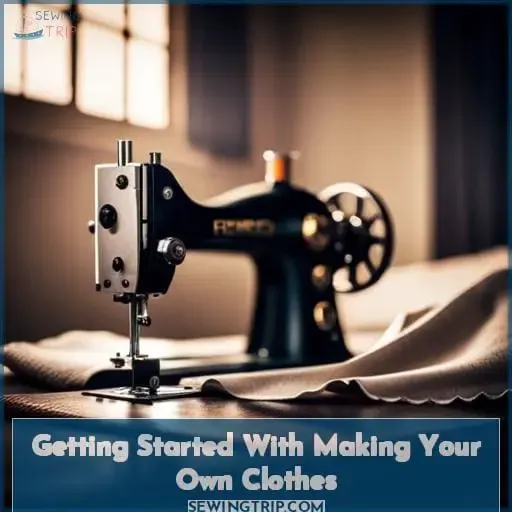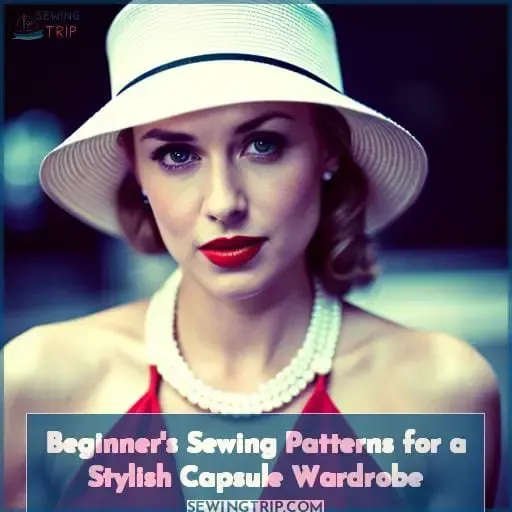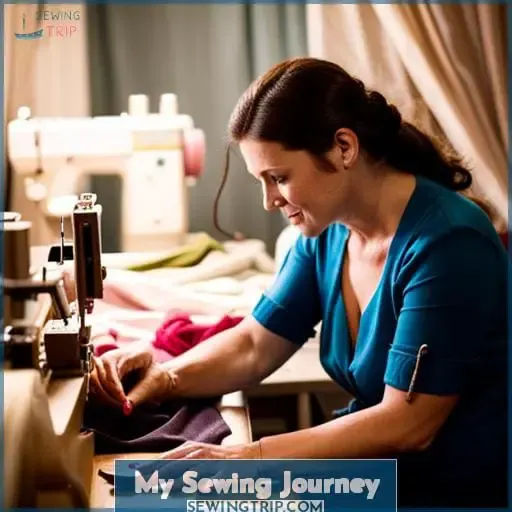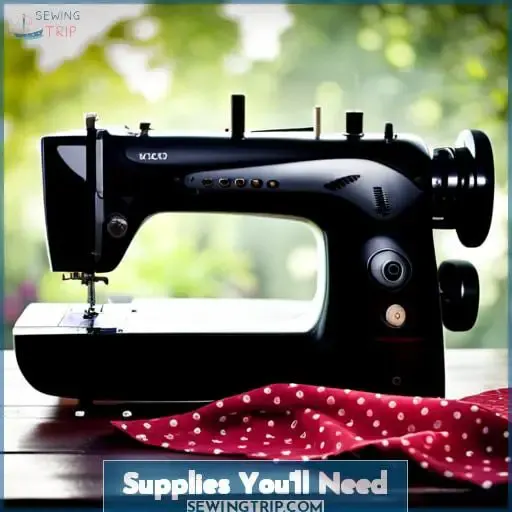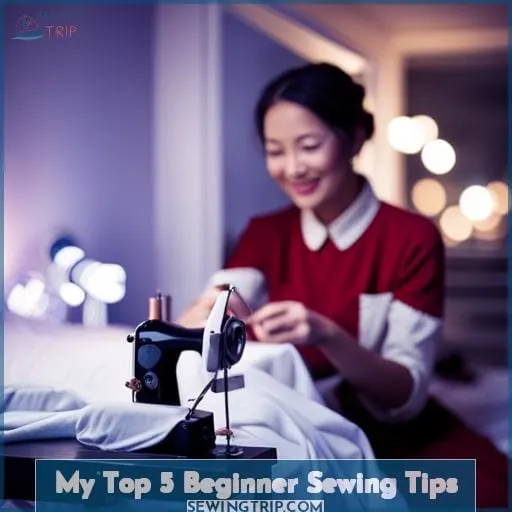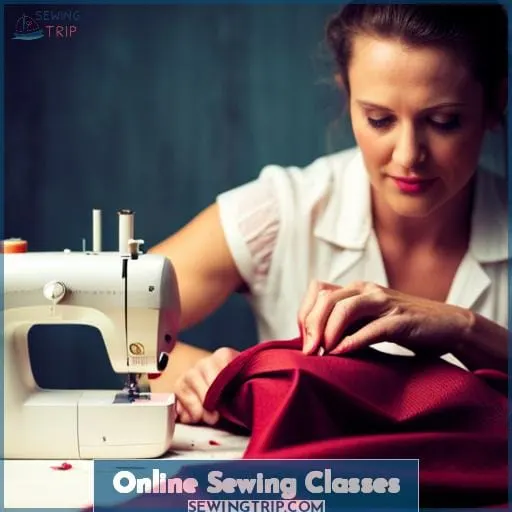This site is supported by our readers. We may earn a commission, at no cost to you, if you purchase through links.
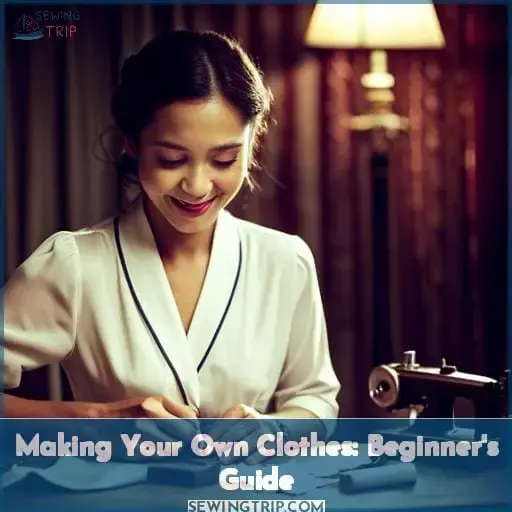 Embark on a transformative journey of self-expression through the art of making clothes. Discover the joy and fulfillment that comes with creating your own unique style.
Embark on a transformative journey of self-expression through the art of making clothes. Discover the joy and fulfillment that comes with creating your own unique style.
In this beginner’s guide to making your own clothes, you’ll learn essential sewing techniques, choose the perfect patterns and fabrics, and unlock your creative potential.
With each stitch, you’ll gain confidence in your abilities as a fashion designer extraordinaire.
Table Of Contents
Key Takeaways
- Choose an entry-level sewing machine from reputable brands like Singer or Brother.
- Research beginner-friendly sewing patterns online.
- Consider fabric choices and skill progression when selecting patterns.
- Explore different fabrics like cotton or linen for durability and breathability.
Getting Started With Making Your Own Clothes
Now that you’re ready to embark on your journey of making your own clothes, it’s important to choose the right sewing machine and pattern.
Look for an entry-level sewing machine from reputable brands like Singer or Brother, and familiarize yourself with its basic functions.
Explore beginner-friendly patterns from sources such as Peppermint Magazine or Seamwork, ensuring they align with your skill level and desired style.
Choosing the Right Sewing Machine and Pattern
First, you’ll need to choose a sewing machine and pattern that are suitable for beginners like yourself.
Look for entry-level sewing machines from reputable brands like Singer or Brother.
Research online resources for beginner-friendly sewing patterns such as dress patterns or skirt patterns.
Consider your fabric choices and skill progression when selecting the right pattern.
Selecting the Right Fabric and Supplies
When starting to make your own clothes, it’s essential to focus on selecting the right fabric and supplies that will suit your project.
Explore different fabrics like cotton or linen for their durability and breathability.
Consider sustainable choices such as organic cotton or recycled polyester for an eco-friendly approach.
Don’t forget about essential sewing supplies like a sewing machine, fabric scissors, pins, and thread.
To save money, look for sales or use coupons when purchasing fabrics and sewing supplies.
Beginner’s Sewing Patterns for a Stylish Capsule Wardrobe
As you embark on your journey of making your own clothes, it’s important to find beginner-friendly sewing patterns that will help you create a stylish capsule wardrobe.
Discover wonderful skirt patterns like The Ultimate Pencil Skirt or explore easy-to-sew options for beginners.
Additionally, don’t forget to embrace the versatility and comfort of knit fabrics with patterns such as The Bettine Dress or casual knit dresses like The Marianne Dress and The Aurum Dress.
Discovering Wonderful Skirt Patterns
Explore a variety of stylish skirt patterns that are perfect for beginners looking to create their own capsule wardrobe.
Discover different skirt styles from pencil skirts to A-line skirts, and choose the pattern that suits your style.
Select fabrics like cotton or linen for a classic look, or experiment with bold prints and textures for unique combinations.
Enhance your sewing techniques by following beginner sewing tips found in dressmaking books or online tutorials.
Don’t be afraid to unleash your creativity and master the art of making beautiful skirts!
Tips for Successful Sewing
Looking to sew a stylish capsule wardrobe?
Wondering how to ensure successful sewing with beginner-friendly patterns?
Master the art of stitching perfection and creative embellishments by honing your sewing skills.
Choose easy sewing patterns that cater to your level of expertise.
Select fabrics wisely, considering their suitability for the pattern and your skill level.
Troubleshoot any issues along the way with online sewing classes or helpful tips from experienced sewers.
My Sewing Journey
As you embark on your sewing journey, it’s important to reflect on your personal experiences and background in order to shape your approach to making your own clothes.
Your sewing progress will be marked by various learning challenges along the way, but don’t let that discourage you. Remember those inspirational moments when everything came together perfectly and celebrate them as small victories.
The sewing community is a valuable resource where you can find support, advice, and encouragement from fellow sewists who understand the joys and frustrations of dressmaking.
And finally, remember to cherish each creation as they become your favorite pieces in your wardrobe.
So dive into the world of sewing with enthusiasm and determination knowing that every stitch brings you closer to mastery over this empowering craft.
- Reflect on past experiences
- Embrace learning challenges
- Seek inspiration from others in the Sewing Community
- Cherish each creation
Supplies You’ll Need
To get started making your own clothes, you’ll need essential sewing supplies. These tools will help you bring your creative vision to life and ensure successful garment construction.
| Sewing Tools | Organizational Tips |
|---|---|
| Sewing machine | Keep a dedicated space for all of your sewing supplies. |
| Fabric scissors | Use storage containers or bins to keep everything organized. |
| Pins and needles | Label different compartments or drawers for easy access to specific items. |
| Measuring tape | Create a system for organizing fabric scraps based on size, color, or type. |
These basic supplies will allow you to mend seams, hem garments, and embark on beginner projects with confidence. As you explore fabrics and expand your skills in the world of sewing, consider investing in additional notions such as buttons, elastic bands,and bias tape.
Patterns
Now that you have gathered all the necessary supplies, it’s time to dive into the exciting world of patterns.
Patterns are like blueprints for your garments, guiding you through the construction process and helping you achieve your desired style. As a beginner, it’s important to select patterns that are suitable for your skill level and preferences.
Start by exploring different styles and designs that interest you. Whether it’s a flowy dress or a tailored blazer, there’s sure to be a pattern out there that suits your taste. Look for beginner-friendly patterns labeled as such or with terms like quick or easy.
Once you’ve chosen a pattern, consider how fabric choices will impact the final result of your garment. The recommended fabric types provided in the pattern will guide you in making informed decisions about what fabrics work best with each design.
Assembling and following sewing techniques outlined within patterns may present some challenges initially but don’t let this discourage you! Embrace these opportunities as chances to learn new skills along the way.
Fabric
Where can you find the right fabric for your sewing projects?
When it comes to selecting fabric, there are plenty of options available to you. Here’s a list of online retailers where you can find a wide range of fabrics:
- Fabrics.com: This popular online store offers an extensive selection of woven and knit fabrics, perfect for any sewing project.
- Mood Fabrics: Known for their high-quality materials, Mood Fabrics is a go-to destination for both fashion designers and home sewists.
- Organic Cotton Plus: If sustainability is important to you, check out Organic Cotton Plus. They offer sustainable fiber options like organic cotton and hemp.
When choosing the right fabric type, consider factors such as weight (lightweight vs. heavyweight) and durability. Understanding these different aspects will help ensure that your finished garment looks professional and lasts longer in your wardrobe.
My Top 5 Beginner Sewing Tips
If you’re just starting out with sewing, here are my top 5 beginner sewing tips to help you on your journey:
- Start with simple projects:
- Begin by tackling easy-to-sew projects like elastic-waist or pajama pants.
- This will allow you to practice basic techniques and build confidence.
- Practice on scrap fabric:
- Before working on your main garment, take the time to practice different stitches and techniques on scrap fabric.
- This will help refine your skills without the pressure of ruining expensive material.
- Read the entire pattern before starting:
- It’s important to read through the entire pattern instructions before beginning any project.
- This ensures that you understand each step and can anticipate any potential challenges along the way.
- Try on the garment as you go for fit adjustments:
- Don’t wait until a project is complete to check if it fits properly.
- Try it on throughout the process so that you can make necessary adjustments for a better fit in real-time.
Online Sewing Classes
You can easily enhance your sewing skills by taking advantage of the wide array of online sewing classes available.
Whether you’re a beginner looking to learn the basics or an intermediate sewist wanting to expand your knowledge, there are affordable and even free options for everyone.
The best online sewing classes provide step-by-step instructions and helpful tips from experienced instructors, allowing you to master new techniques at your own pace.
From beginner courses that teach you how to repair ripped jeans or create simple DIY projects, to intermediate classes that delve into more complex topics like sustainable fashion and knit dress patterns, these online resources offer a convenient way for you to gain mastery over the art of sewing from the comfort of your own home.
Frequently Asked Questions (FAQs)
How do I choose the right sewing machine for making my own clothes?
To choose the right sewing machine for making your own clothes, consider entry-level machines like Brother’s cs6000i.
Learn basic functions and techniques through online resources.
Explore beginner-friendly patterns from sources like Seamwork and Peppermint Magazine to unleash your creative potential.
What are some beginner-friendly sewing patterns for creating a stylish capsule wardrobe?
Create a stylish capsule wardrobe with beginner-friendly sewing patterns like:
- The Ultimate Pencil Skirt
- Easy-to-sew skirt patterns
- Casual knit dress patterns
Explore options from independent designers for your journey towards liberation and mastery in fashion.
Where can I find reliable resources for learning how to sew?
To find reliable resources for learning how to sew, check out online platforms like Craftsy and Sewing.
They offer a wide range of tutorials, courses, and articles to help you master the art of sewing.
What types of fabric are best for beginners to work with when making clothes?
When starting out in your sewing journey, opt for easy-to-work-with fabrics like cotton and linen.
These fabrics provide stability and are forgiving to mistakes, allowing you to gain confidence as you create your own stylish garments.
Are there any tips for staying motivated and inspired throughout the sewing journey?
Stay motivated in your sewing journey by pretending you’re a fashion deity, designing clothes that will make everyone bow down to your mastery.
Conclusion
Step into the world of self-expression and creative fulfillment by making your own clothes.
With the beginner’s guide provided, you’ll have all the tools and knowledge you need to embark on this transformative journey.
From choosing the right sewing machine and patterns to selecting the perfect fabric and supplies, you’ll be well-equipped to create your own unique style.
With each stitch, you’ll gain confidence and unlock your inner fashion designer.
So, don’t wait any longer – it’s time to start making clothes and take control of your wardrobe destiny!

